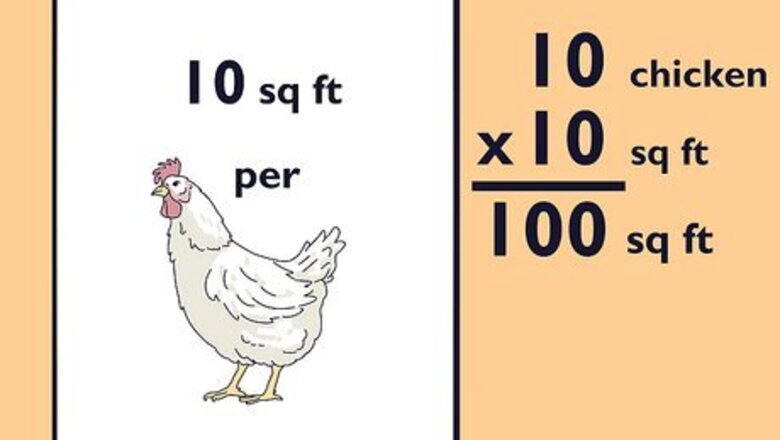
views
- Find a space with at least 10 sq ft (0.93 m2) per chicken and plenty of shade in warmer climates, or full sun in cooler climates.
- Sink fence posts along the perimeter, with each post 6 to 8 ft (1.8 to 2.4 m) from one another. Then nail 2 × 4 in (5.1 × 10.2 cm) boards across the top of the posts.
- Wrap the perimeter in chicken wire, sinking the wire at least 4 in (10 cm) into the ground to deter predators. Also lay the chicken wire over the top of the run.
Planning the Size and Location
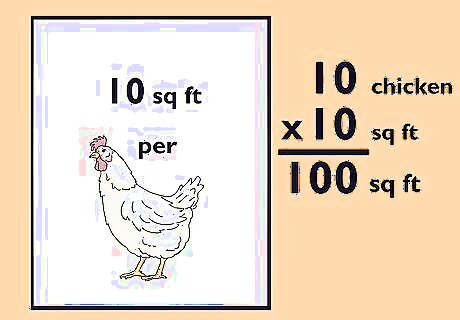
Create at least 10 sq ft (0.93 m) of outdoor space per chicken. Count how many chickens you have and calculate the total area your run needs to be. For example, if you have 10 chickens, you would need 100 sq ft (9.3 m) minimum for your chickens to be comfortable. Build your chicken run larger than you need if you plan to grow your flock in the coming years.
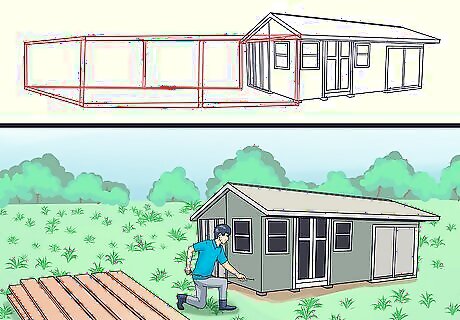
Plan the layout of your run next to your chicken coop. Lay boards on the ground to get an idea of the shape and size your chicken run will be. Aim to make the sides similar in length rather than long and narrow. This gives your chickens more room for roaming around. Measure the planned length and width of the run to find the total area. Compare the area of the chicken run to the minimum requirement for the size of your flock. Make sure one of the sides aligns with the small door built into the coop so the chickens can get in and out. If your coop doesn’t have a small door, cut one into the side with a saw. Think about where you want to install the gate so you can access the run easily. Account for how tall you need to make your run. You should comfortably be able to walk in and out of the run once it’s finished, so it should be over 6 ft (1.8 m) tall.
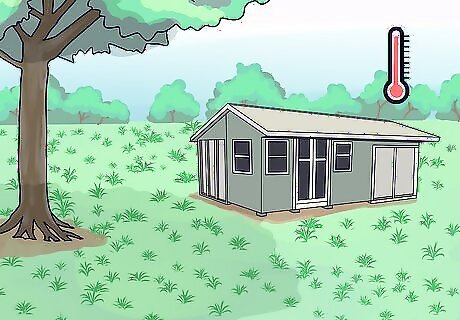
Keep the run in the shade in warmer climates. Temperatures consistently over 90 °F (32 °C) can be lethal for chickens if they’re in direct heat. Chickens adapt to the cold better than the heat, so make sure the run isn’t in direct heat. Build your run so it has tree cover or another source of consistent shade throughout the day. Plant new trees near your run if you don’t have any existing shade.
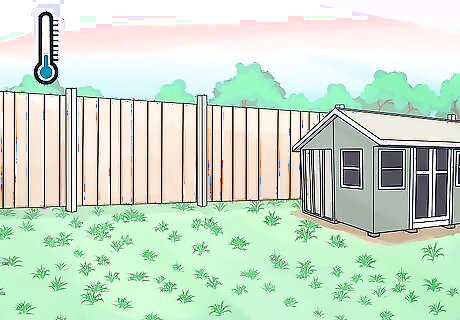
Let the run get full sun in cooler climates. Chickens can easily survive in low temperatures, but they don’t want to be cold all of the time. If you live in a climate that gets below 20 °F (−7 °C) often, make sure your run isn’t shaded. Find an area that gets even amounts of sun and shade throughout the day if you live in a climate that gets extreme highs and lows.
Placing Posts and Building the Frame
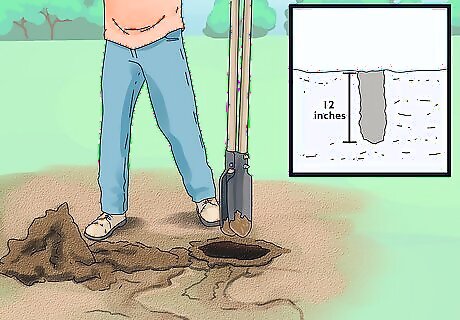
Dig a hole 12 in (30 cm) deep for your first fence post. Place the first 4 in × 4 in (10 cm × 10 cm) fence post about 3 ft (0.91 m) from your coop so you can place a gate there. Use a shovel or a post digger to make a hole that is 6 in (15 cm) on each side. Make sure your fence posts are at least 7 ft (2.1 m) tall. Place a 2 in (5.1 cm) layer of gravel on the bottom of the hole to protect the post’s end from moisture. Opt for a rot-resistant wood like cedar or white oak for your fence posts and supports.
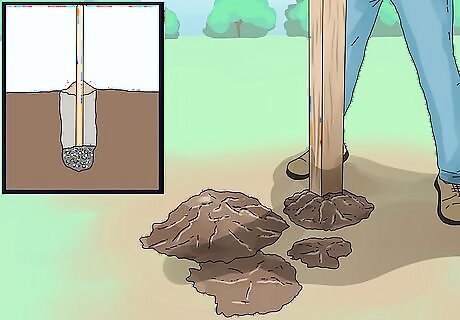
Set the post in the hole and pack the soil back in. Hold the pole firmly while you fill it back in with the dirt you removed. Compact the dirt with the bottom of your shovel or with your foot around the entire post. Use the extra dirt to form a mound around the bottom of the post to keep it in place. Make concrete to fill your hole to keep your post from rotting in the future if you want.
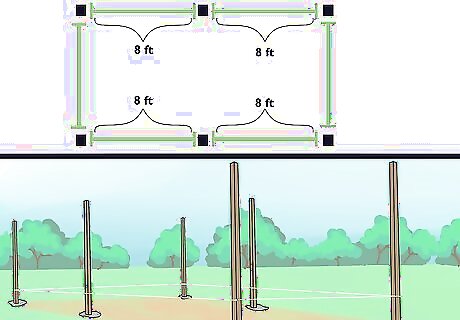
Space the other fence posts 6 to 8 ft (1.8 to 2.4 m) from one another. Use a tape measure to make sure the fence posts are equal distances apart so your chicken run has even support. Make sure the posts on opposite sides are in line with one another. Dig a hole and place the posts until they’re all set. If your run is larger than 10 ft (3.0 m) wide, put a fence post inside the run for an added support beam. Make sure the post is in line with the outer posts on each side. Saw the tops of the fence posts to the same height if they aren’t on level ground. Use a handsaw and a level so all of your posts are the same height. Make your chicken run at least 6 ft (1.8 m) tall so you can easily walk inside.
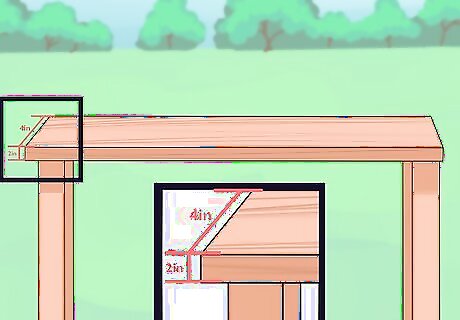
Attach 2 in × 4 in (5.1 cm × 10.2 cm) boards across the top of the run. Run the boards horizontally so they go from one fence post on one side to a post on the other side. Use a drill with the screwdriver bit attached to attach 3 in (7.6 cm) wood screws to the top of the fence posts. If you have supports in the middle of your run, make sure to attach screws to them as well.
Installing the Fencing
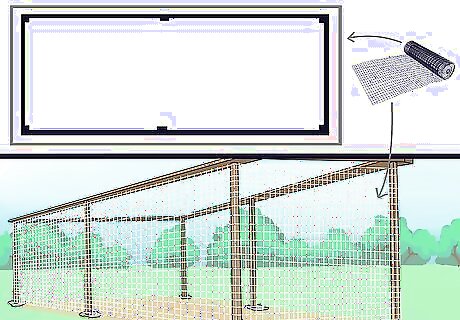
Use ⁄2 to 1 in (1.3 to 2.5 cm) welded wire to keep out predators. Calculate the area of fencing you need by measuring the height and length of one side of your run and multiplying them together. Add 4 inches (10 cm) to each height measurement as excess. Repeat this for each side as well as the top of the run and add the areas together to find the total amount of fencing you need. Fencing can be purchased at your local hardware or farm animal care stores. The wire is small enough so raccoons, foxes, and weasels are kept out of your run and coop. If you have larger predators in your area, such as bears, use a chain link dog fence wrapped in smaller welded wires to protect your birds. Fencing on top of the chicken run will help protect your flock from owls, hawks, and other predatory birds.
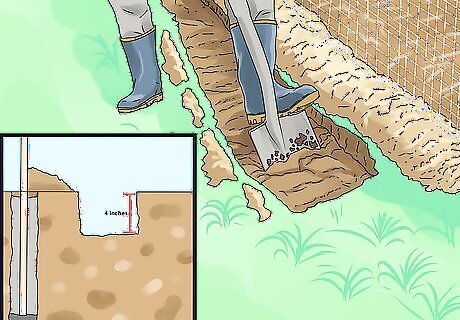
Dig a 4 in (10 cm) deep trench around the perimeter of your run. Use a shovel to dig your trench. Place the bottom of your fence in the trench on the outside of the fence posts and fill the dirt back in. Having your fence below the ground will protect your flock from digging animals like foxes and coyotes.
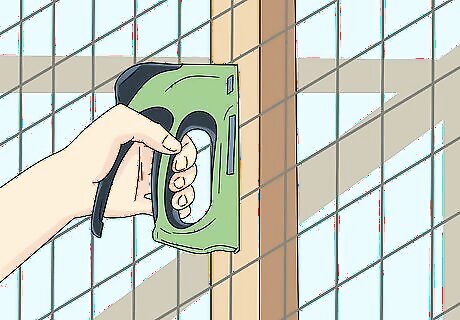
Staple the fence every 6 in (15 cm) to the fence posts. Wrap the fence horizontally around the outside of the fence posts. Use a staple gun or a hammer to drive U-shaped staples into the fence posts. Place the staple in the middle of the post so that the ends of the staple go into 2 different links. Leave a gap in the fencing where you plan to hang your gate.
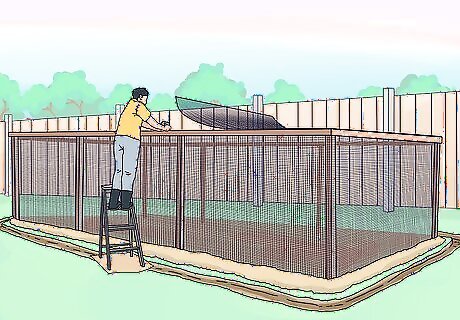
Lay the fence on top of the run. Use a ladder to reach the top of your run and cover the entire area with fencing to keep out flying or climbing predators, like hawks or raccoons. Staple the fence on top of the posts you’ve set in the ground to secure it.
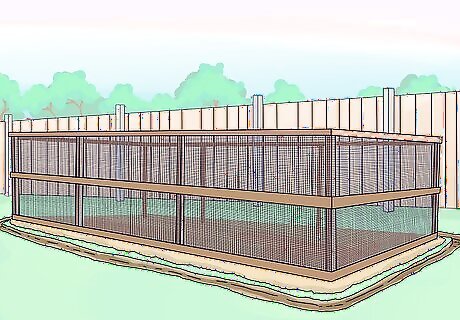
Frame your fence with 2 in × 4 in (5.1 cm × 10.2 cm) boards to secure it. First, screw horizontal supports on the top, middle, and bottom of each fence post so the fence is sandwiched between the wood. Use your drill and wood screws to keep the boards in place and make sure they are flush with one another. Then add boards vertically between the horizontal supports by screwing them in every 1 ft (30 cm).
Adding Finishing Touches
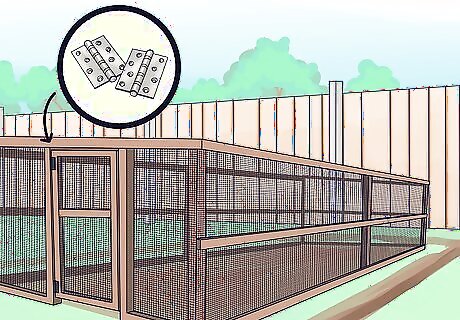
Install a gate with a spring so the door shuts automatically. Attach 2 hinges 18 in (46 cm) from the top and bottom of the fence post with screws and a drill. Hang the door so the bottom is flush with the ground. Screw in the hinges on the side of the door to attach it. Hook one end of a hooked spring to the fencing on the gate and the other end to the fencing of your run. Gate doors can be purchased or built on your own. Make sure the door opens out from the run. Otherwise, the spring won’t force the door closed. Make sure the spring is tight and unstretched. This way, the gate will snap back into place after it’s been opened.

Line the bottom of the run with straw or a bedding alternative. Spread chopped straw evenly on the ground of the run so your chickens feel comfortable while they are outside. Alternatives to straw are leaves, construction-grade sand, or wood shavings. Chopped straw can be purchased at your local farm care store. Rake your leaves into the run in the fall once they start to fall for free outdoor bedding. Change the bedding once it starts to smell or once it looks soiled.
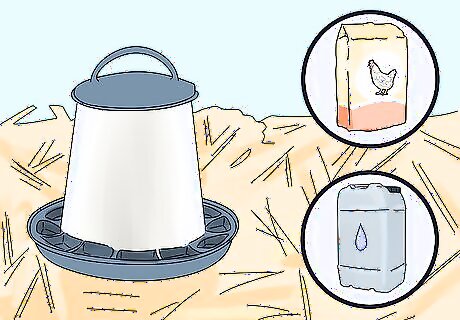
Place a container of food and water inside the run. Cover the top of the feeder with foil so your chickens can’t get into it and so it is protected from the elements. Hang a chicken waterer from one of the supports on the top of your run with an eye-bolt so the water stays clean. If your coop has enough space, keep your food and water inside to protect it from the elements and mold. Make sure the chickens all can fit comfortably inside along with them.














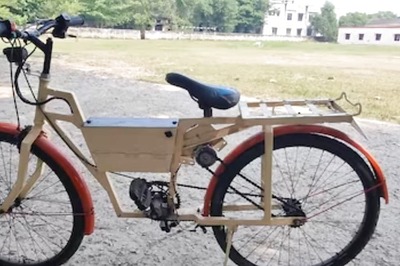




Comments
0 comment